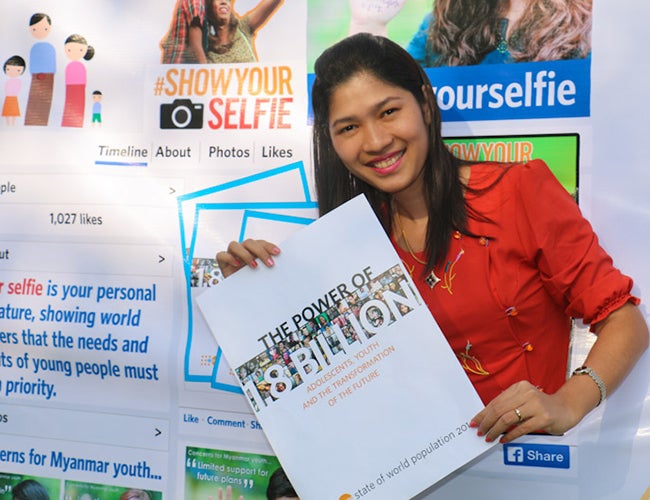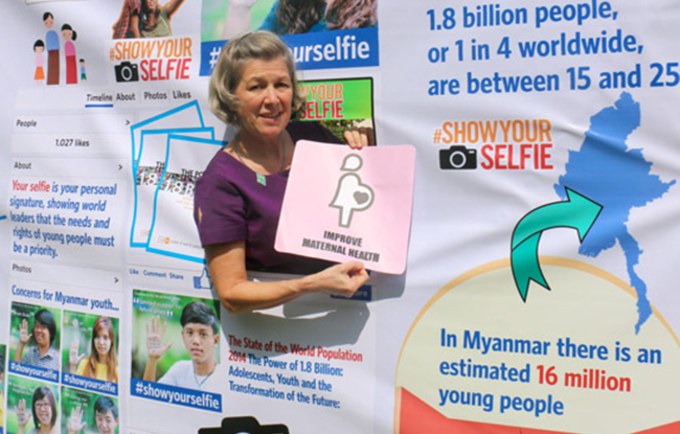Yangon, Myanmar__ Nine in ten of the world’s 1.8 billion young people today live in less-developed countries. Because of lagging social services, these countries face greater obstacles to leverage the advantages that can result from engaging a youthful, productive workforce. More than 1 billion of these youths live in Asia and the Pacific region, constituting for half of the world’s global youth population.
The United Nations Population Fund (UNFPA) highlights in its annual flagship publication State of the World Population (SWOP), released globally on the 18th of November, that developing countries with large youth populations could see their economies soar, provided they invest heavily in young people’s education, health and protection of their rights. The report, The Power of 1.8 Billion: Adolescents, Youth and the Transformation of the Future, calls for action for urgently investing in young people so that they can be engaged in their communities and the development of their nations. “Never again is there likely to be such potential for economic and social progress.”
In Myanmar, before the provisional census results were released it was estimated that young people aged between 15-24 years old represent at least 16 million. The exact figure will be known in May 2015. With this large youthful potential during a time of change and transformation, the need for youth to get a quality education and become skilled and employable, is all the more pressing.
Ahead of the official handover of the 2014 State of the World Population 2014 report to the Government, UNFPA is launching a social media Selfie campaign dubbed, “Lend your voice to help transform the Future” as part of the global#SHOWYOURSELFIE. The social media campaign encourages Myanmar youth to be a voice for transforming the future of young people across the country. The campaign will end on 1 December and all submitted entries will be displayed at a press conference to be held in early December.
This year’s SWOP report highlights the enormous potential for economic growth and social development in countries with large youth populations, provided that there is investment in human and social capital for youth. Ms. Janet Jackson, UNFPA Myanmar Representative said that “with concerted effort in ensuring youth are given quality education and adequate skills, they will have a better chance to reach their full potential and therefore become a powerful force for economic growth and development, thus building better prospects for themselves.”
Ms. Jackson also emphasized that “UNFPA is committed to working with the Myanmar youth so that they can be a driving force for positive change in society at large. To achieve this we need to ensure that they have better access to information and can access sexual reproductive health services, and that there is equal opportunity for boys and girls to receive and complete a quality education.”
Official figures from the report show that up to 60 per cent of young people in developing regions are not working or in school, or have only irregular employment. According to official World Bank figures from 2012 Myanmar is classified as a low income level country with a youth unemployment rate of 11.5% amongst 15-24 year olds. In Myanmar the report illustrates that despite the ongoing reforms, only 46 per cent of boys and 48 per cent of girls enroll in secondary education, showing a critical need to further push for better investment and capacity building of the country’s youth population.
According to the UNFPA State of the World Population (SWOP) report some 120 million young people across the globe reach working age every year. Despite these large numbers, more than 500 million youth in the world struggle to survive on less than $2 per day. The UNFPA flagship publication calls for further implementation in policies to create jobs and improve young people’s employability. The report stresses that “with the right policies and investment in human capital, countries can empower young people to drive economic and social development and boost per capita income.”
“Today’s record 1.8 billion young people present an enormous opportunity to transform the future,” said UNFPA Executive Director, Dr. Babatunde Ostimehim in the official State of the World press release sent out at the global launch in New York. “Young people are the innovators, creators, builders and leaders of the future. But they can transform the future only if they have the skills, health, decision-making, and real choices in life.”
The Myanmar youth Selfie campaign starts on 19 November 2014. Participants will be encouraged to post a self-portrait (Selfie) photo of themselves in their community UNFPAs social media sites,www.facebook.com/showyourselfiemmr or https://twitter.com/unfpammr .
The Selfie campaign will ask youth three questions: 1) What are your hopes for the future? 2) What are your fears 3) What aspirations do you have for your future and that of your community? A summary of all the youth entries will be presented during the official launch of the UNFPA official flagship publication State of the World Population (SWOP) 2014, The Power of 1.8 Billion: Adolescents, Youth and the Transformation of the Future.



